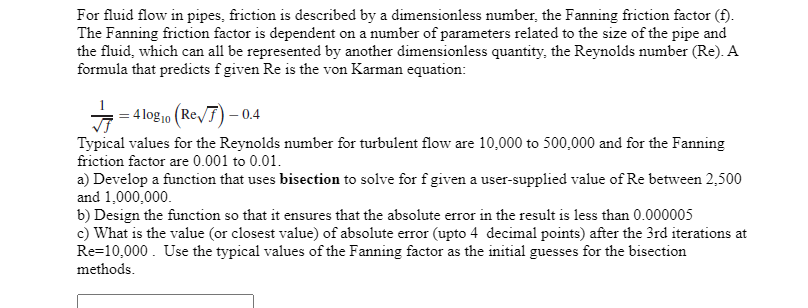For fluid flow in pipes, friction is described by a dimensionless number, the Fanning friction factor (f). The Fanning friction factor is dependent on a number of parameters related to the size of the pipe and the fluid, which can all be represented by another dimensionless quantity, the Reynolds number (Re). A formula that predicts f given Re is the von Karman equation: 7= 4 log10 (Re/7) – 0.4 Typical values for the Reynolds number for turbulent flow are 10,000 to 500,000 and for the Fanning friction factor are 0.001 to 0.01. a) Develop a function that uses bisection to solve for f given a user-supplied value of Re between 2,500 and 1,000,000. b) Design the function so that it ensures that the absolute error in the result is less than 0.000005 c) What is the value (or closest value) of absolute error (unto 4 decimal points) after the 3rd iterations at
For fluid flow in pipes, friction is described by a dimensionless number, the Fanning friction factor (f). The Fanning friction factor is dependent on a number of parameters related to the size of the pipe and the fluid, which can all be represented by another dimensionless quantity, the Reynolds number (Re). A formula that predicts f given Re is the von Karman equation: 7= 4 log10 (Re/7) – 0.4 Typical values for the Reynolds number for turbulent flow are 10,000 to 500,000 and for the Fanning friction factor are 0.001 to 0.01. a) Develop a function that uses bisection to solve for f given a user-supplied value of Re between 2,500 and 1,000,000. b) Design the function so that it ensures that the absolute error in the result is less than 0.000005 c) What is the value (or closest value) of absolute error (unto 4 decimal points) after the 3rd iterations at
Engineering Fundamentals: An Introduction to Engineering (MindTap Course List)
5th Edition
ISBN:9781305084766
Author:Saeed Moaveni
Publisher:Saeed Moaveni
Chapter6: Fundamental Dimensions And Units
Section: Chapter Questions
Problem 22P
Related questions
Question
100%
2

Transcribed Image Text:For fluid flow in pipes, friction is described by a dimensionless number, the Fanning friction factor (f).
The Fanning friction factor is dependent on a number of parameters related to the size of the pipe and
the fluid, which can all be represented by another dimensionless quantity, the Reynolds number (Re). A
formula that predicts f given Re is the von Karman equation:
= 4 log10 (Re/F) – 0.4
Typical values for the Reynolds number for turbulent flow are 10,000 to 500,000 and for the Fanning
friction factor are 0.001 to 0.01.
a) Develop a function that uses bisection to solve for f given a user-supplied value of Re between 2,500
and 1,000,000.
b) Design the function so that it ensures that the absolute error in the result is less than 0.000005
c) What is the value (or closest value) of absolute error (upto 4 decimal points) after the 3rd iterations at
Re=10,000. Use the typical values of the Fanning factor as the initial guesses for the bisection
methods.
Expert Solution
This question has been solved!
Explore an expertly crafted, step-by-step solution for a thorough understanding of key concepts.
This is a popular solution!
Trending now
This is a popular solution!
Step by step
Solved in 3 steps

Knowledge Booster
Learn more about
Need a deep-dive on the concept behind this application? Look no further. Learn more about this topic, civil-engineering and related others by exploring similar questions and additional content below.Recommended textbooks for you

Engineering Fundamentals: An Introduction to Engi…
Civil Engineering
ISBN:
9781305084766
Author:
Saeed Moaveni
Publisher:
Cengage Learning

Engineering Fundamentals: An Introduction to Engi…
Civil Engineering
ISBN:
9781305084766
Author:
Saeed Moaveni
Publisher:
Cengage Learning